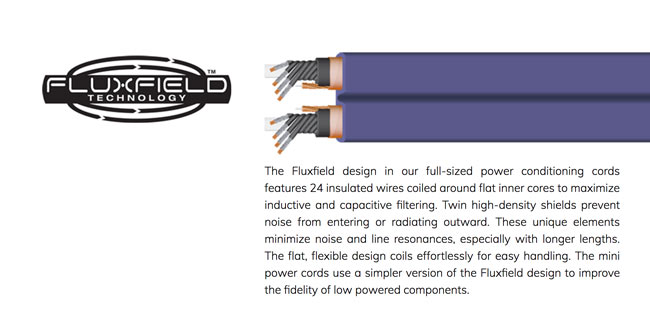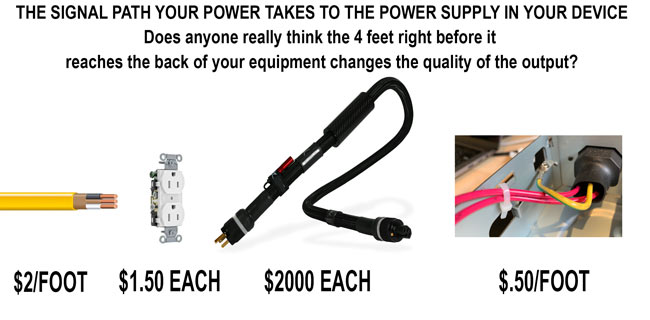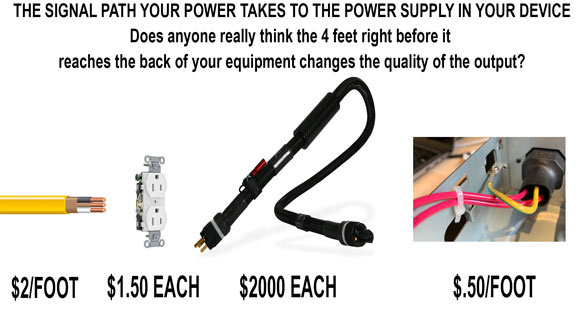Cables, Cables and More!
You want to guarantee lots of clicks or comments on your blog, audio site, or FB page? Write about cables. My last piece on the nonsense of power cables prompted a lot of responses and apparently inspired some other writers and group managers to take up the topic. Steven Stone wrote a piece over at Audiophile Review titled, “Can Power Cords Have an Effect on an Audio System’s Sound?” yesterday where he asked a couple of audio authorities to weigh in on the topic. David Salz, the founder and a principal of WireWorld, wrote a long explanation full of techno jargon in full support of power cords causing “great improvements in music reproduction”. Not surprising as his company sells power cords costing upwards of $1700. I’ve meet David, experienced his demos where “dramatic improvements” were promised, and left unimpressed. The counter argument was left to Tommy O’Brien of The Digital Amplifier Company. His assessment? “If people think beefing up the last 10% of 60 foot run is going to make a difference, they will be sadly mistaken”.

Others with “years of listening experience” respond to my ardent skepticism with the usual push back: “If you can’t hear differences between power cords, then be glad because you’re saving a lot of money” or “Your system isn’t good enough — it doesn’t resolve with sufficient clarity — to allow you to detect the very real differences”. When I point out that I’ve been mixing and mastering award-winning, high-end music for 40 years and that my professional studio includes Meridian, Bryston, and B&W equipment, the exchanges usually cease. But engineering and scientific facts rarely change anyone’s opinions on cables.

I know a few of the people running the cable companies. Ray Kimber is a friend and Greg at DH Labs has generously provided interconnects and speaker cables for my demos at AXPONA. These companies have succeeded because audiophiles believe what they read, they believe the advertising, they believe the reviewers, and they take subjective opinions as scientific facts. It’s unfortunate but is unlikely to stop anytime soon.
A Real Expert Offers His Insight
I received a lengthy private email from a real expert — a bona fide electrical engineer who designs and evaluates cables for a living — that I have shared below. I hope that those stuck in the fog of cable nonsense will read it and start the process back to critical and objective reality. It’s unlikely that anyone will change their mind, but at least those writing on the topic will have another — this time unbiased — source to quote.
Hello Dr. Waldrep,
I’d like to thank you for maintaining this site and being the voice of reason in this time of great misinformation.
I am a professional electronics engineer; my day today work involves figuring out signal integrity for fast digital interfaces on and between printed circuit boards; many of these operating well into multi-gigahertz regime. That’s a good 4-5 orders of magnitudes higher bandwidth than anything encountered in audio applications. And often that’s done over…you guess it…copper cables. At those frequencies just about anything looks like a distributed transmission line. And more importantly so much energy is lost in the cables to the point that waveform through the cable barely resemble the waveform presented to the cable — and yet if managed properly, which is what my job encompasses, these digital interfaces work flawlessly!
But let’s return back to audio band. I recently bought a pair of 6 foot RCA cables between my USB-based 24/192K DAC driving a set of my home studio near field monitors, to replace a shorter pair I had used prior. After reading numerous online reviews, I selected a pair of $11 reasonably well-made 75 ohm stranded center conductor coaxial cables on Amazon. That’s $13 a pair. Not $1100. Not even $110. How could I commit such a heresy? In my view, pretty simple.
At audio frequencies a 6 ft analog interconnect still acts like a wire. It is not a distributed transmission line. I don’t have to think of reflections. A wavelength of say 100 kHz sine in a 80% velocity cable (pretty typical of modern 75ohm coaxial cables, e.g. Belden 8241F) is 3.7 kilometers. Even a 1000ft cable can’t possibly act like a transmission line, even as we talk ultrasonic. So manufacturers tagging audio cables as some kind of superior transmission line cables should check their facts – unless you are planning to run your analog audio straight across the country!
That means my cable is a wire that can be simply modeled as lumped series resistance, series inductance and shunt capacitance per unit length. With that, the physics of this is easy to analyze with standard circuits theory in the context of my set up. According to the manual for my DAC and monitors, the output and input impedance (resistance) is 25ohms and 10 kOhms, respectively. 0.25% of the signal is lost no matter what. Not a huge loss – in fact I highly doubt the golden eared could catch something so minor.
Series resistance of a cable is a DC (as in zero Hertz) and represents the net amplitude loss – in this case voltage division between output impedance and cable + input impedance. For (eg. Belden 8241F) the series resistance is 105.6mOhm/6ft. Against 10K load resistance this series resistance is completely negligible – in other words 10000 ohm + 0.106 = 10000.106ohm is for all practical purposes still the same 10000 ohm (in fact component tolerances in the input circuit of my monitor will most certainly exceed that level of precision). That eliminates me from needing some kind of ultra-low resistive esoterically constructed super-conducting metals or some such.
Next I look at the series inductance. For Belden 8241F is is rated at 0.54uH/6ft. That’s likely measured at (almost canonically accepted) frequency of 1MHz. This brings up the question of skin effect. At 100KHz one skin depth in copper is approximately 0.2mm. The cable we’ve been looking at so far has a 30 AWG center conductor that has a radius of 0.12mm. That means even at ultrasonic frequencies the current does not redistribute itself too much within the center conductor. (The shield is braided and that means skin effect is even less pronounced there due to a multitude of small-diameter conductors that construct this braid). The inductance, then, (as well as AC resistance) varies no more than 1-2% over entire audio band. So the series inductance for this cable of 0.54uH/6ft translates to a whopping extra 0.339ohm of series reactance introduced by the cable, and that’s at 1MHz. I’d say that’s just as negligible against 10000 ohms just as is the series resistance. So there goes the line of manufacturers claiming that their cables improve sound because of reduction of skin effect. It’s pretty humorous to consider the readings with claims about improvements due to gold platings and so on. (By the way, the cable I purchases is a stranded conductor which makes it even more tolerant of skin effect loss).
Finally the shunt capacitance. Our coax cable is specified with capacitance of 103pF/6ft. At 100KHz that’s a reactance of 15452 Ohms. That’s noticeable against my 10K input load, but since I am source by 25ohm output the net effect is only additional 0.16% of signal loss up there! (1) I am pretty sure I can’t hear 0.16% signal drop and (2) I am pretty sure I can’t hear much at 100 kHz anyway. Situation only improves in my favor when I lower my requirements to the frequencies I can hear.
What about dielectric loss? Once again at audio frequencies the conductivity for typical coaxial cable dielectrics is still in the megaohms.
What about claims of improved RF shielding? RF signals could be picked up by the cable as a receiving antenna? However in just about any coaxial cable skin depth of the outer conductor/braid is much thicker than that of the high frequency RF signal and cannot penetrate down to the center conductor. These high frequency currents could instead flow along the outer conductor to the input. The amount of this pickup is function of length of this antenna and the RF frequency in question. And it has to do with how the input mixes the RF signal down to an audible band. But it has nothing to do with how many layers are found in the outer conductor or whether some exotic metal is used as opposed to copper.
That’s it then. My conclusion is, as long as electrical characteristics of my purchase are on par with “inexpensive and commonly used standard cable akin to those that have been around for decades” then anything else doesn’t buy me any benefit.
The wheel has been fully invented. Fortunately the science of copper interconnects has been pretty much 100% understood all the way from DC to tens of gigahertz (where if not the case, I would have tremendous trouble designing my fast digital interfaces). Rather than misleading potential buyers with useless and confusing specs, audio cable manufacturers need only to publish the 3 parameters that are of most interest. But none of them do!
By the way, I replaced my exiting cables with my new purchase. Had I not replaced them myself, I don’t think I would have ever noticed the swap. It was a negligible-loss operation (both acoustically and financially).
My profound thanks for the author sharing his years of expertise and explaining in factual, objective terms how audio cables work. It would be wise for writers, audiophiles, and designer cable companies to understand the basics before contributing to the debate.
++++++++++++++++++++++++++++++++++++++++++++++++++++++++++++++++

My younger brother is in need of some help. This isn’t the place or platform to relate the details of his current situation but I know some of you might consider making a contribution to the GoFundMe campaign I started for him once you read the narrative I authored. In fact, since I posted this a week ago, many readers have given generously…thank you!
I wouldn’t make this appeal if I didn’t feel his circumstance was compelling and the person worthy. If you want to read more, please click the link below and consider making a contribution.
To thank anyone that makes a donation of $100 or more, I will send a signed copy of my “Music and Audio: A User Guide to Better Sound” (with Blu-ray Demo disc) AND a FREE copy of the latest AIX Records sampler— a $25 value. If you contribute $50 – $100, I’ll send the eBook, downloadable files, and the AIX sampler. Finally, for a donation of $25 – $50, you’ll receive the eBook and demo files.
I will cover all shipping expenses for domestic orders. International shipping will be additional.
Click here to be taken to the GoFundMe page.
Please do not share this link. Thanks for your consideration. And thanks to those that have generously contributed to the GoFundMe campaign!


I have a high quality home audio system and while I don’t use ultra expensive cabling I do prefer premium cabling products to compliment the appearance and construction of my audio gear over cheap cabling offerings. I did find the expert’s findings somewhat lacking, e.g., “I don’t think…” and “I highly doubt…”. If he is so sure there is no difference then why the hedging?
That’s what you took away from this article from an educated professional, William; a semantic argument over the author taking some literary license with his sentence structure? If you want to buy sexy, expensive cables, great! Do so often and unapologetically. “I buy them because I like them” is a perfectly acceptable answer. Giving a man a hard time because he injected what must be the world’s smallest amount of subjectivity into an otherwise completely objective summary seems petty. Enjoy your shiny new cables. I’ll spend my pennies saved on some subjectively tasty beer to drink while I listen to my FLAC collection. Without fail, it objectively makes EVERYTHING sound better.
William, I don’t think he was hedging his statements about cables. And I would agree with you that the only reason I can see to purchase designer cables is because of the way they look. I’ve honestly thought about starting a company that would simply wrap around existing IEC cables and make them look “designer”.
I’ll buy into that company! We’ll make a mint and laugh all the way to the bank.
Thank you for the Dr. AIX post about cables. Your EE friend is 100% correct in his analysis. I am also an EE and have been designing and installing audio products and systems since the late 60s. I spent 13 years working at Shure in the 60s and 70s, including many hours in controlled listening tests. In some of these, we were trying to figure out why we could hear things we did not know how to measure. Transient intermodulation distortion was one such cause. But magic cables were not.
I’ve been designing and installing high end home cinemas since 1992, and I do not sell magic cables. I have participated in listening demos at trade shows like CEDIA, CES, and AES, and whenever I wasted my time listening to magic interconnect cables or magic passive power cords, there was nothing there. Yet the audio press that was present would sometimes agree with the advertiser that they heard the magic. One point to add to the mix – when replacing regular interconnects with magic ones, you can sometimes hear a difference because the replacement operation cleans the connectors of the associated equipment. But removing and replacing the original cords would do the same.
Hope the GoFundMe campaign is going well. I’m in.
If you are handy with electronics and really want to compare cables to each other or to an ideal cable, a shunt, some effort and a little money can get you a test rig to make instantaneous comparisons. For power you’ll need two DPDT make before break relays, preferably with a DC coil you can operate with batteries, a few feet of 12 gage Romex, a high quality plug like a Hubbell 5266C, and a high quality connector, usually and IEC type for your amplifier or whatever. Since your house is wired with Romex (or BX can be substituted if you live in certain jurisdictions where it is required) You can made two half cord sets that go to the common terminals of each relay. The other terminals get connected to the cords you want to test, one on each side or for a shunt for one side to compare to use a short length of more Romex. Be very careful to get the polarity right or you will have a short circuit that will trip your circuit breaker when you switch. Make sure the A side and B side of the relays are connected to the same wire and be sure the relay contacts can handle the current. 20 or more amps should be more than sufficient. Since you are not interrupting power during switching there will be no inductive arc on the relay contacts. The relays will make a seamless connection from one wire to the other so that there are no interruptions, no thumps, no anything.
For stereo speaker cables or interconnects you’ll need two such setups, one for each channel and appropriate connectors. A pair of 4PDT make before break relays can also be used. Then you can perform your own AB tests, sighted, or with the assistance of someone else throwing the switch and keeping score, blind or even double blind.
If anyone tries it I’d like to hear about the results here. Why haven’t I done it myself? Because frankly I couldn’t care less. I have much bigger fish to fry. Even if I knew it mattered I wouldn’t spend extra money on expensive cables..
Dr. R.A. Greiner, a prof at U of Wisconsin, addressed this issue at length in the Journal of the Audio Engineering Society back in 1980, and also in audio magazines at the time. The EE posting at top of this thread is correct. In the case of speaker cables, there are cases in which one cable makes a particular speaker sound better than another, because there may be design issues with both the speaker and the cable that cancel each other. Properly sized (large) ordinary lamp cord works fine as speaker wire.
In the case of speakers (and headphones) the situation is slightly different in that (very) low impedances involved. As such, cable series resistance and inductance that contribute few tenths of an ohm start to matter. An asymmetrically constructed coaxial cable doesn’t make as much sense in this context, yet a low guage stranded copper wiring akin to those used in common power wiring works pretty well. Shielding speaker cables here is useless because it would take rather obscure amounts of electromagnetic fields coupling onto the cable in order to drive a low impedance transducer to audible levels. And at audio frequencies electromagnetic coupling coefficient for cables of any practical length are nearly zero (arguably much higher RF frequencies can back couple into the amplifier stage with intermixed down to audio frequencies and amplified, but that to me just constitutes poorly grounded/shielded amplification more so than an issue with choice of speaker wiring).
It’s all about the impedances involved.